CONTENTS

POSH TOAST


TOAST is a pretty humble food. Perhaps it was the first solid food you were allowed to hold in your hand and post into your own mouth. You probably got melted butter all over your clothes, your face and your high chair but its the sheer, unalloyed delight of managing to feed yourself (to the beaming approval of your mum and dad) that imprints toast early in life as most peoples favourite food. Everybody loves toast. Dont trust anyone who doesnt. On the face of it, nothing could be simpler than making toast a little heat, judiciously applied to scorch a piece of bread.
And yet each of us has a set of personal preferences about how toast should be made and served: our own individual Code of Toast. Depending on the bread used, most of us have a very particular preference for levels of doneness. These days all manner of hi-tech toasters are available, some with conveyor belts, some of which claim to read the colour of the toast with a photocell, some with simple timers but most of us cant resist intervening. Every toaster requires constant, neurotic jockeying, frequent checks on brownness if horrible breakfast disappointment is to be avoided. And what disappointment it can be. Who amongst us has never burned the toast? Who has not allowed the last piece of bread in the house to be catastrophically carbonised the doomed attempt to scrape off the burned bits and the whole day, subtly, but appreciably thrown into a sense of sadness and failure.
There is similar partisan passion concerning the serving temperature. Some believe the toast should be brought to the table at a temperature that sears the fingertips, all the better to melt the butter and absorb it. Others otherwise sensible people, whose judgement in most matters is usually to be trusted want their toast cold so that great curling waves of butter can be piled onto the surface without melting. Its here that the toast rack comes into play: toast-making, like any great art form, is a matter of balancing like an acrobat on the precipice of disaster. Toasting bread is unlike any other form of cooking. For the perfect finish, the toast must be warm, moist and steaming on the inside, crisp and dry on the outside.
If toast is allowed to cool flat on a plate or breadboard, the steam in the centre is trapped and causes the crust to become unappealingly soft. There is nothing as disheartening as soggy toast. The toast rack is, therefore, the only tool by which one can allow the toast to cool in freely circulating air, allowing the steam to escape and retaining crispness. That crisp surface is the result of the Maillard reaction, a process of non-enzymatic browning, caramelisation and finally pyrolisis a very posh way of saying crisp and delicious. This also explains why you cant make toast in an oven or microwave. You need something that can hold the bread in place while intense heat is applied to the surfaces.
An electric toaster is ideal; searing in a hot, dry pan is a good substitute, but best of all is a toasting fork and a fire. Toast is the most elemental of foods, simple yet complex, utterly plain yet deserving of infinite tweaks and enhancements. Toast can be reassuringly humble or very, very posh. Now. what shall we put on it? 

 Bagels Bagels are made from a slightly sweetened yeast dough which is poached in boiling water for a short time before baking. This sets a tough, elastic crust which keeps the texture of the bagel tight and firm.
Bagels Bagels are made from a slightly sweetened yeast dough which is poached in boiling water for a short time before baking. This sets a tough, elastic crust which keeps the texture of the bagel tight and firm.
Bagels toast well, particularly when a little stale. Baguette A good baguette is already extremely crisp-crusted so toasting can make it laceratingly sharp. That said, the open, airy crumb texture means that baguette toast has a great affinity for anything that benefits from soaking up. Bloomer (Crusty White or Brown) Bloomer is a British name for a hand-shaped crusty white or brown loaf. Its cooked directly on the oven floor and relies on an elastic crust to hold its distinctive cushion shape. Taste can vary but its a popular general-purpose loaf with good texture and toasting qualities.
Brioche A French yeast bread, enriched with butter, milk and eggs the latter of which give it a lovely yellow colour. Brioche makes a fluffy, light toast with a pronounced sweetness, so it works well with jams and preserves but also, strangely, with pts and foie gras. Challah Challah is a traditional Jewish bread, usually made in a braided pattern. It tastes a lot like brioche and toasts in the same way, but it is parve (the neutral category in Kosher foods) so contains no dairy products. Ciabatta Ciabatta conjures up images of a centuries-old Italian tradition but in fact it was invented in 1982 specifically for sandwich making. The flavour is mild, the texture open and the crust soft.
It toasts up a treat. Cornbread Good cornbread has a fudgy, cake-like consistency and is made with ground cornmeal instead of flour. Baking powder is used as a raising agent which means that a slight saltiness tempers the sweetness of the corn. Cornbread is difficult to brown and crisp but that hardly matters as its so delicious in its naked state. Corn Tortilla Corn tortillas are clearly not toast at all, but they make a fantastic base for toppings of all kinds. Made with finely ground cornmeal, they can be loaded up with Mexican-inspired ingredients, and once fried or toasted retain their crunch well.
Farmhouse Farmhouse generally indicates a more rustic loaf. Expect a tougher crust, perhaps a less regular crumb texture, but a more robust and yeasty flavour. If the bread is very moist and fresh, slice it and allow it to stand in the toaster (switched off) for an hour or two, which will dry it out a little. Flatbread A whole family of unleavened or lightly leavened breads from all corners of the globe. Flatbread is made by stretching out the dough on a griddle or slapping it onto the walls of the oven. As it has a closed, unaerated texture, it becomes crisp and brittle with toasting.
Granary Granary flour is a product of the Hovis company, made by malting the basic grain, crushing and roasting before adding to brown flour and baking. It produces a dark, complex-flavoured loaf with good moisture, excellent keeping properties and the malt gives a smoky sweetness. Granary toasts well and is sturdy enough to stand up to weighty toppings. Pan Pugliese Pan pugliese is one of dozens of regional types of basic Italian rustic bread. Its made with white flour and olive oil but is salted much less than many breads. Its particularly good when stale and toasted in a lightly oiled frying pan.

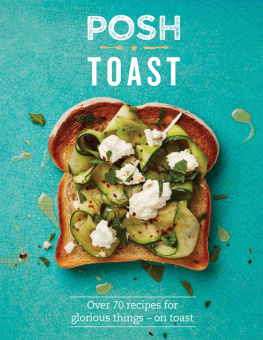
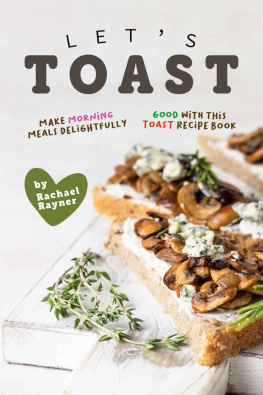
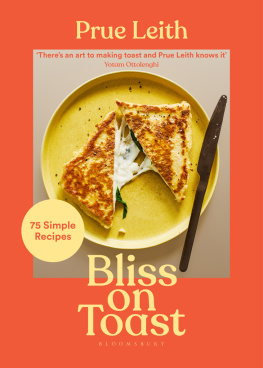

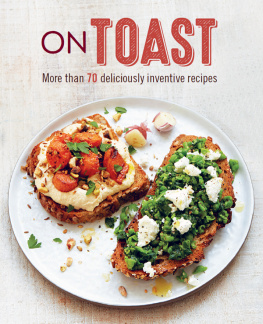

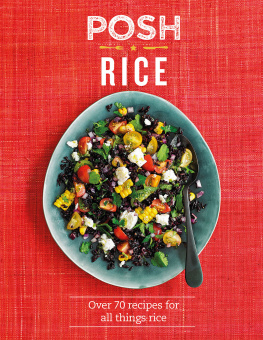
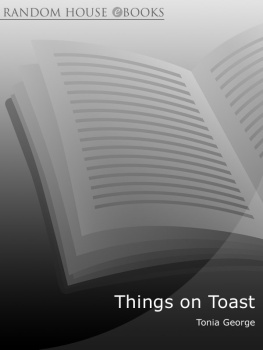
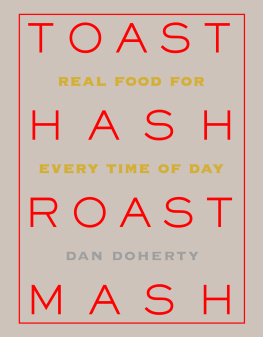
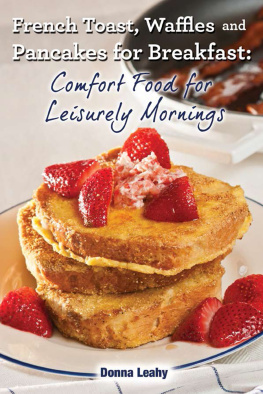



 POSH TOAST
POSH TOAST 
 TOAST is a pretty humble food. Perhaps it was the first solid food you were allowed to hold in your hand and post into your own mouth. You probably got melted butter all over your clothes, your face and your high chair but its the sheer, unalloyed delight of managing to feed yourself (to the beaming approval of your mum and dad) that imprints toast early in life as most peoples favourite food. Everybody loves toast. Dont trust anyone who doesnt. On the face of it, nothing could be simpler than making toast a little heat, judiciously applied to scorch a piece of bread.
TOAST is a pretty humble food. Perhaps it was the first solid food you were allowed to hold in your hand and post into your own mouth. You probably got melted butter all over your clothes, your face and your high chair but its the sheer, unalloyed delight of managing to feed yourself (to the beaming approval of your mum and dad) that imprints toast early in life as most peoples favourite food. Everybody loves toast. Dont trust anyone who doesnt. On the face of it, nothing could be simpler than making toast a little heat, judiciously applied to scorch a piece of bread. 

 Bagels Bagels are made from a slightly sweetened yeast dough which is poached in boiling water for a short time before baking. This sets a tough, elastic crust which keeps the texture of the bagel tight and firm.
Bagels Bagels are made from a slightly sweetened yeast dough which is poached in boiling water for a short time before baking. This sets a tough, elastic crust which keeps the texture of the bagel tight and firm.